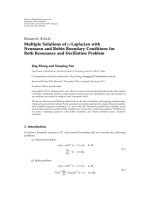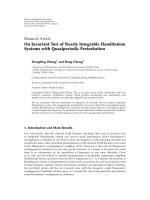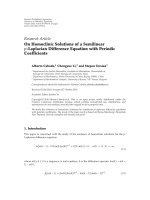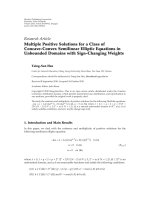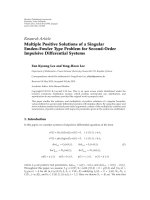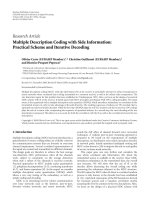Báo cáo hóa học: " Research Article Multiple Periodic Solutions to Nonlinear Discrete Hamiltonian Systems" doc
Bạn đang xem bản rút gọn của tài liệu. Xem và tải ngay bản đầy đủ của tài liệu tại đây (544.58 KB, 13 trang )
Hindawi Publishing Corporation
Advances in Difference Equations
Volume 2007, Article ID 41830, 13 pages
doi:10.1155/2007/41830
Research Article
Multiple Periodic Solutions to Nonlinear Discrete
Hamiltonian Systems
Bo Zheng
Received 15 April 2007; Revised 27 June 2007; Accepted 19 August 2007
Recommended by Ondrej Dosly
An existence result of multiple periodic solutions to the asymptotically linear discrete
Hamiltonian systems is obtained by using the Morse index theory.
Copyright © 2007 Bo Zheng. This is an open access article distributed under the Creative
Commons Attribution License, which permits unrestricted use, distribution, and repro-
duction in a ny medium, provided the original work is properly cited.
1. Introduction
Let
Z and R be the sets of all integers and real numbers, respectively. For a,b ∈ Z,define
Z(a) ={a,a +1, } and Z(a,b) ={a,a +1, , b} when a ≤ b.LetA be an n ×m matrix.
A
τ
denotes the tr anspose of A.Whenn = m, σ(A)anddet(A) denote the set of eigenvalues
and the determinant of A, respectively.
In this paper, we study the existence of multiple p-periodic solutions to the following
discrete Hamiltonian systems:
Δx(n)
= J∇H
Lx(n)
, n ∈ Z, (1.1)
where p>2isaprimeinteger,Δx(n)
= x(n +1)−x(n), x(n) =
x
1
(n)
x
2
(n)
with x
i
(n) ∈ R
d
,
i
= 1, 2, L is defined by Lx(n) =
x
1
(n+1)
x
2
(n)
, J =
0 −I
d
I
d
0
is the standard symplectic matrix
with I
d
the identity matrix on R
d
, H ∈ C
1
(R
2d
,R), and ∇H(z) denotes the gradient of H
in z.
We may think of systems (1.1) as being a discrete analog of the following Hamiltonian
systems:
˙
x
= J∇H
x(t)
, t ∈ R, (1.2)
2AdvancesinDifference Equations
which has been studied extensively by many scholars. For example, by using the cr itical
point theory, some significant results for the existence and multiplicity of per iodic and
subharmonic solutions to (1.2)wereobtainedin[1–5].
Some authors have also contributed to the study of (1.1) for the disconjugacy, bound-
ary value problems, oscillations, and asymptotic behavior, see, for example, [6–9]. In
recent years, existence and multiplicity results of periodic solutions to discrete Hamil-
tonian systems employing the minimax theory and the geometrical index theory have
appeared in the literature. For example, for the case that H is superquadratic both at zero
and at infinity, by using the Z
2
geometrical index theory and the linking theorem, some
sufficient conditions for the existence of multiple periodic solutions and subharmonic
solutions to (1.1)wereobtainedin[10]. For the case that H is subquadratic at infinity,
some sufficient conditions on the existence of periodic solutions to (1.1)wereprovedin
[11] by using the saddle point theorem. Recently, in [12], the authors have obtained some
sufficient conditions on the multiplicity results of periodic solutions to a class of second
difference equation by using the Z
p
geometrical index theory. Our main purpose in this
paper is to give a lower bound of the number of p-p eriodic solutions to (1.1) by using the
Morse index theory and a multiplicity result in [12].
The rest of this paper is organized as follows. In Section 2, we present some useful
preliminary results. In Section 3, we firstly introduce the Morse index theory for the p-
periodic linear Hamiltonian systems:
Δx(n)
= JS(n)Lx(n), n ∈ Z, (1.3)
where S(n) is a real symmetric positive definite 2d
×2d matrix with S(n + p) = S(n)for
every n
∈ Z, and then, for any real symmetric positive definite matrix S,wedefineapair
of index functions (i(S, p),ν(S, p))
∈ Z(0,2dp) ×Z(0,2dp) and obtain the formulae of the
computations of index functions for a diagonal positive definite matrix. In Section 4,by
using the Morse index theory and a multiplicity result in [12], we establish a result on
the existence of multiple periodic solutions to (1.1)whereH satisfies the asymptotically
linear conditions.
2. Preliminaries
In order to apply the Morse index theory to study the existence of multiple p-per iodic
solutions to (1.1), we now state some basic notations and useful lemmas.
Let Ω be the set of sequences x
={x(n)}
n∈Z
, that is,
Ω
=
x =
x(n)
|
x(n) =
x
1
(n)
x
2
(n)
∈ R
2d
, x
j
(n) ∈ R
d
, j =1,2, n ∈Z
. (2.1)
x can be rewritten as x
= ( ,x
τ
(−n), ,x
τ
(−1),x
τ
(0),x
τ
(1), ,x
τ
(n), )
τ
.Forany
Bo Zheng 3
x, y
∈ Ω, a,b ∈ R, ax + by is defined by
ax + by
ax(n)+by(n)
=
,ax
τ
(−n)+by
τ
(−n), ,ax
τ
(−1) + by
τ
(−1),ax
τ
(0) + by
τ
(0),
ax
τ
(1) + by
τ
(1), ,ax
τ
(n)+by
τ
(n),
τ
.
(2.2)
Then Ω is a vector space.
For any given prime integer p>2, E
p
is defined as a subspace of Ω by
E
p
=
x =
x(n)
∈
Ω | x(n + p) = x(n), n ∈Z
. (2.3)
E
p
can be equipped with the norm ·
E
p
and the inner product ·,·
E
p
as follows:
x
E
p
=
p
n=1
x(n)
2
1/2
, x, y
E
p
=
p
n=1
x(n), y(n)
, (2.4)
where
|·|denotes the usual Euclidean norm and (·,·) denotes the usual scalar product
in
R
2d
.
Define a linear map Γ : E
p
→ R
2dp
by
Γx
=
x
1
1
(1), ,x
d
1
(1),x
1
1
(2), ,x
d
1
(2), ,x
1
1
(p), ,x
d
1
(p),
x
1
2
(1), ,x
d
2
(1),x
1
2
(2), ,x
d
2
(2), ,x
1
2
(p), ,x
d
2
(p)
τ
,
(2.5)
where x ={x(n)} and x(i) = (x
1
1
(i), ,x
d
1
(i),x
1
2
(i), ,x
d
2
(i))
τ
for i ∈ Z(1, p). It is easy to
see that the map Γ is a linear homeomorphism with
x
E
p
=|Γx| and (E
p
,·,·
E
p
)isa
Hilbert space which can be identified with
R
2dp
.
To get a decomposition of the Hilbert space E
p
, in the following we discuss the eigen-
value problem:
Δx(n)
= λJLx(n), n ∈ Z, x(n + p) = x(n), (2.6)
where λ
∈ R.
It is obvious that λ
= 0isaneigenvalueof(2.6) whose eigenfunction can be given by
η
0
(n) =
a
1
,a
2
, ,a
2d
τ
, a
i
∈ R, i =1,2, ,2d, n =1,2, , p. (2.7)
By a simple computation, (2.6)isequivalentto
Δx
1
(n) =−λx
2
(n), x
1
(n + p) = x
1
(n),
Δx
2
(n −1) = λx
1
(n), x
2
(n + p) = x
2
(n).
(2.8)
If λ
= 0, then (2.8)isequivalentto
Δ
2
x
1
(n −1) + λ
2
x
1
(n) = 0, x
1
(n + p) = x
1
(n),
Δ
2
x
2
(n −1) + λ
2
x
2
(n) = 0, x
2
(n + p) = x
2
(n).
(2.9)
4AdvancesinDifference Equations
It is known that (2.9) has a nontrivial solution if and only if λ
2
= λ
2
k
= 4sin
2
(kπ/p)with
k
∈ Z(1,(p −1)/2),see,forexample,[13, 14]. So in this case (2.6) has a nontrivial solu-
tionifandonlyifλ
= λ
k
= 2sin(kπ/p)withk ∈ Z(−(p −1)/2,(p −1)/2)\{0}.Itiseasy
to see that the multiplicities of λ
k
for each k ∈ Z(−(p −1)/2,(p −1)/2) are of the same
number 2d.
To get an explicit decomposition of the Hilbert space E
p
, in the following, we also need
to compute eigenfunctions of (2.6) corresponding to each λ
k
, k = 0.
Fix a k
∈ Z(−(p −1)/2, −1) ∪Z(1,(p −1)/2), any solutions to (2.9)canbewrittenas
x
1
(n) = c
1
cos(kwn)+c
2
sin(kwn), x
2
(n) = d
1
cos(kwn)+d
2
sin(kwn), (2.10)
where w
= 2π/p and c
1
, c
2
, d
1
, d
2
are constant vectors in R
d
. Using the relation between
x
1
, x
2
, that is, (2.8)withλ = λ
k
,wehave
c
1
sin
kw
2
−
c
2
cos
kw
2
=
d
1
,
c
2
sin
kw
2
+ c
1
cos
kw
2
=
d
2
.
(2.11)
If we choose c
1
= e
j
, c
2
= 0, then d
1
= sin(kw/2)e
j
, d
2
= cos(kw/2)e
j
;ifwechoosec
1
= 0,
c
2
= e
j
,thend
1
=−cos(kw/2)e
j
, d
2
= sin(kw/2)e
j
,wheree
j
, j = 1,2, ,d denotes the
canonical basis of
R
d
. So, eigenfunctions of (2.6) corresponding to each λ
k
(k = 0) can be
given as
η
(1)
k, j
(n) =
⎛
⎜
⎝
cos(kwn)e
j
sin
kw
n +
1
2
e
j
⎞
⎟
⎠
, n = 1,2, , p,
η
(2)
k, j
(n) =
⎛
⎜
⎝
sin(kwn)e
j
−cos
kw
n +
1
2
e
j
⎞
⎟
⎠
, n = 1,2, , p.
(2.12)
Hereto, E
p
can be decomposed as E
p
= X ⊕X
1
⊕X
2
with
X
=
x =
x(n)
|
x(n)=c
1
e
1
+ c
2
e
2
+···+c
2d
e
2d
, c
i
∈ R, i =1,2, ,2d, n =1,2, , p
,
X
1
=
x =
x(n)
|
x(n) =
d
j=1
(p
−1)/2
k=1
α
k, j
η
(1)
k, j
(n)+
d
j=1
−1
k=−(p−1)/2
α
k, j
η
(1)
k, j
(n), α
k, j
∈ R
,
X
2
=
x =
x(n)
|
x(n) =
d
j=1
(p
−1)/2
k=1
β
k, j
η
(2)
k, j
(n)+
d
j=1
−1
k=−(p−1)/2
β
k, j
η
(2)
k, j
(n), β
k, j
∈ R
.
(2.13)
Finally, we briefly introduce t he Z
p
geometrical index theory which can be found in [12].
Define a linear operator μ : E
p
→ E
p
as follows. For any x ∈E
p
,
μx(n)
= x(n +1), ∀n ∈ Z. (2.14)
Bo Zheng 5
Clearly, for any x
∈ E
p
, μ
p
x = x and μx
E
p
=x
E
p
.Soμ is an isometric action of group
Z
p
on E
p
. It is easy to see that Fix
μ
:={x ∈ E
p
| μx = x}=X.
Note that if x is a periodic solution to (1.1) with period p,thenμx is also a periodic
solution to (1.1) with period p.Wecall
x={μx,μ
2
x, ,μ
p
x} a Z
p
-orbit of period so-
lution x to (1.1) with period p.
Let E be a Banach space and let μ be a linear isometric action of Z
p
on E.Namely,μ is
a linear operator on E satisfying
μx=x for any x ∈E and μ
p
= id
E
,whereZ
p
is the
cyclic group with order p and id
E
is the identity map on E.
AsubsetA
⊂ E is called μ-invariant if μ(A) ⊂A. A continuous map f : A →E is called
μ-equivariant if f (μx)
= μf(x)foranyx ∈ A. A continuous functional F : E → R is said
to be μ-invariant if for any x
∈ E, F(μx) = F(x).
Let us recall the definition of the Palais-Smale condition.
Let E be a real Banach space and F
∈ C
1
(E,R). F is said to satisfy the Palais-Smale
condition ((PS) condition) if any sequence
{x
(m)
}⊂E for which {F(x
(m)
)} is bounded
and F
(x
(m)
) → 0(m →∞) possesses a convergent subsequence in E.
Our result is based on the following theorem (see [12, Theorem 2.1]).
Theorem 2.1. Let F
∈ C
1
(E,R) be a μ-invariant functional satisfying the “PS” condition.
Let Y and Z be closed μ-invariant subspaces of E with codimY and dimZ finite and
codimY<dimZ. (2.15)
Assume that the following conditions are satisfied.
(F1) Fix
μ
⊂ Y, Z ∩Fix
μ
={0};
(F2) inf
x∈Y
F(x) > −∞;
(F3) there ex ist r>0 and c<0 such that F(x)
≤ c whenever x ∈ Z and x=r;
(F4) if x
∈ Fix
μ
and F
(x) = 0, then F(x) ≥ 0.
Then there exist at least dimZ
−codimY distinct Z
p
-orbits of critical points of F outside of
Fix
μ
with critical value less or equal to c.
The following estimate will be useful in the subsequent sections.
Proposition 2.2. For any x
∈ E
p
, the following inequality holds:
p
n=1
Δx(n)
2
≤ 2
1+cos
π
p
p
n=1
x(n)
2
. (2.16)
Proof. We note that
p
n=1
Δx(n)
2
= 2
p
n=1
x(n),x(n)
−
x(n +1),x(n)
=
(AΓx, Γx), (2.17)
6AdvancesinDifference Equations
where
A
=
⎛
⎜
⎜
⎜
⎜
⎝
B 0
B
.
.
.
0 B
⎞
⎟
⎟
⎟
⎟
⎠
2dp×2dp
with B =
⎛
⎜
⎜
⎜
⎜
⎜
⎜
⎜
⎜
⎝
2 −10··· 0 −1
−12−1 ··· 00
0
−12··· 00
··· ··· ··· ··· ··· ···
000··· 2 −1
−10 0··· −12
⎞
⎟
⎟
⎟
⎟
⎟
⎟
⎟
⎟
⎠
p×p
.
(2.18)
It follows from [15]thatp distinct eigenvalues of matrix B are
λ
k
= 4sin
2
(kπ/p)with
k
∈ Z(0, p − 1) and λ
max
= max{λ
k
| k ∈ Z(0, p − 1)}=2(1 + cos(π/p)). Since |Γx|
2
=
x
2
E
p
=
T
n
=1
|x(n)|
2
, inequality (2.16) now follows from (2.17).
Remark 2.3. Noticing that the set of eigenvalues {λ
k
| k ∈ Z(−(p −1)/2,(p −1)/2)} is
bounded from below by
−2 and bounded from above by 2 which are different from the
differential case. S o, we can avoid the fussy process of finding the dual action which is
necessary for the differential case (see [ 4, Chapter 7]).
3. The Morse index of a linear positive definite Hamiltonian systems
In this section, we define a pair of index functions (i(S, p), ν(S, p))
∈ Z(0,2dp) ×Z(0,2dp)
for any real symmetric positive definite matrix S and obtain the formulae of the compu-
tations of index functions for a diagonal positive definite matrix.
As stated in [10, 11], the corresponding action functional of (1.3)isdefinedonE
p
by
F
S
(x) =
1
2
p
n=1
JΔx(n),Lx(n)
+
S(n)Lx(n),Lx(n)
. (3.1)
Definit ion 3.1. The index i(S, p)istheMorseindexofF
S
, that is, the supremum of the
dimensions of the subspaces of E
p
on which F
S
is negative definite.
Our assumption follows the existence of δ
p
> 0suchthat(S(n)x,x) ≥ δ
p
|x|
2
for ev-
ery n
∈ Z and x ∈ R
2d
. The symmetric bilinear form given by (x, y)
S
=
p
n
=1
(S(n)Lx(n),
Ly(n)) defines an inner product on E
p
. The corresponding norm ·
S
is such that
x
2
S
≥ δ
p
p
n=1
Lx(n)
2
= δ
p
p
n=1
x(n)
2
. (3.2)
Bo Zheng 7
For any x, y
∈ E
p
, if we define a bilinear function as a(x, y) =
p
n
=1
(Jx(n), ΔLy(n −1)),
then by Proposition 2.2 and (3.2)wehave
a(x, y)
≤
p
n=1
Jx(n)
2
1/2
p
n=1
ΔLy(n −1)
2
1/2
=
p
n=1
x(n)
2
1/2
p
n=1
Δy(n)
2
1/2
≤
2
1+cos
π
p
p
n=1
x(n)
2
1/2
p
n=1
y(n)
2
1/2
≤
2
1+cos(π/p)
δ
p
x
S
y
S
.
(3.3)
So, by [16, Theorem 2.2.2], we can define the unique continuous linear operator K on E
p
by (Kx, y)
S
=
p
n
=1
(Jx(n), ΔLy(n −1)). Since
p
n=1
Jx(n), ΔLy(n −1)
=−
p
n=1
JΔx(n),Ly(n)
, (3.4)
we have
2F
S
(x) = (x −Kx, x)
S
. (3.5)
It is obvious that K is self-adjoint. So, it follows from ( 3.5)thatE
p
will be the orthogonal
sum of ker(I
−K) = H
0
(S), H
−
(S)andH
+
(S)withI −K positive definite (resp., negative
definite) on H
+
(S)(resp.,H
−
(S)). Clearly, i(S, p) = dimH
−
(S) ∈ Z(0,2dp). On the other
hand, there exists
δ>0suchthat
(x
−Kx,x)
S
≥ δx
2
S
, x ∈ H
+
(S),
(x
−Kx,x)
S
≤−δx
2
S
, x ∈ H
−
(S).
(3.6)
Setting δ
= δδ
p
> 0, we deduce from (3.2)and(3.5)theestimates
F
S
(x) ≥
δ
2
p
n=1
x(n)
2
, x ∈ H
+
(S), (3.7)
F
S
(x) ≤−
δ
2
p
n=1
x(n)
2
, x ∈ H
−
(S). (3.8)
Definit ion 3.2. The nullity v(S, p) is the dimension of ker(I
−K).
We now state and prove a result which offers another interpretation of the nullity
ν(S, p).
8AdvancesinDifference Equations
Proposition 3.3. ker(I
−K) is isomorphic to the space of solutions to (1.3).
Proof. By the fact that JΔx(n)
= ΔJx(n)wehave
x
∈ ker(I −K) ⇐⇒
(I −K)x, y
S
= 0, ∀y ∈ E
p
,
⇐⇒
p
n=1
S(n)Lx(n),Ly(n)
−
Jx(n), ΔLy(n −1)
=
0, ∀y ∈E
p
,
⇐⇒
p
n=1
ΔJx(n)+S(n)Lx(n), Ly(n)
=
0, ∀y ∈E
p
,
⇐⇒ JΔx(n)+S(n)Lx(n) = 0, n ∈ Z(1, p),
(3.9)
which implies that ker(I
−K) is isomorphic to the space of solutions to (1.3).
To get more information on the index functions, in the following we will compute the
index and the nullity of the diagonal positive definite matrix. By direct computation, it is
easy to get the following.
Proposition 3.4. Let A
= diag{a
1
,a
2
, ,a
2d
}with a
i
> 0, i ∈ Z(1,2d). Then, all the eigen-
values of JA must be pure imaginary and
σ(JA)
=
±
iα
j
| α
j
> 0, j =1,2, ,d
(3.10)
with α
j
=
√
a
j
a
j+d
.
On the formulae of the computations of the index and the nullity, we have the follow-
ing.
Proposition 3.5. For the above matrix A, one has
i(A, p)
= 2
d
j=1
k ∈ Z
1,
p
−1
2
|
α
j
< 2sin
kπ
p
,
ν(A, p)
= 2
d
j=1
k ∈ Z
1,
p
−1
2
|
α
j
= 2sin
kπ
p
.
(3.11)
Proof. If (I
−K)x = λx with x ∈ E
p
,thenforally ∈E
p
,wehave
p
n=1
JΔx(n),Ly(n)
+
ALx(n),Ly(n)
=
p
n=1
AλLx(n), Ly(n)
(3.12)
which implies that
Δx(n)
= JA(1 −λ)Lx(n), n ∈ Z, x(n) = x(n + p). (3.13)
Bo Zheng 9
Assume that the general solutions to (3.13) are of the form
x(n)
= μ
n
ξ = μ
n
ξ
1
ξ
2
, (3.14)
where ξ
1
, ξ
2
are vectors in R
d
.Byx(0) = x(p), we have μ
p
= 1, so μ = e
ikw
, k = 0,1,2, ,
p
−1, where w =2π/p. Therefore, any nontrivial solution to (3.13) can be expressed as
x(n)
= e
ikwn
ξ
1
ξ
2
. (3.15)
Substituting (3.15)into(3.13), we have
2isin
kw
2
ξ
1
ξ
2
=
JA(1 −λ)
e
ikw/2
I
d
0
0 e
−ikw/2
I
d
ξ
1
ξ
2
. (3.16)
Noticing that
σ
JA
e
ikw/2
I
d
0
0 e
−ikw/2
I
d
=
σ(JA), (3.17)
by Definitions 3.1 and 3.2 and Proposition 3.4, we get the conclusion.
4. Periodic solutions to convex asymptotically linear autonomous discrete
Hamiltonian systems
In this section, we consider the existence of multiple p-periodic solutions to (1.1)where
H
∈ C
1
(R
2d
,R) is strictly convex and satisfies the following asymptotically linear condi-
tions:
∇H(x) = A
0
x + o
|
x|
as |x|−→0, (4.1)
∇H(x) = A
∞
x + o
|
x|
as |x|−→∞ (4.2)
with real symmetric positive definite matrices A
0
, A
∞
. Our main result is the following.
Theorem 4.1. Assume that
(A1) v(A
∞
, p) = 0,
(A2) i(A
0
, p) >i(A
∞
, p).
Then (1.1) has at least i(A
0
, p) −i(A
∞
, p) distinct nonconstant Z
p
-periodic orbits.
Remark 4.2. (1) It follows from (A1) and Proposition 3.3 that the linear systems
JΔx(n)+A
∞
Lx(n) = 0, n ∈ Z (4.3)
do not have any nontrivial p-periodic solutions. Thus (A1) is a nonresonance condition
at infinit y.
10 Advances in Difference Equations
(2) Since H is strictly convex and
∇H(0) = 0by(4.1), 0 is the unique equilibrium
point of (1.1). Without loss of generality, we can assume that H(0)
= 0. The action func-
tional of (1.1)definedby
F
H
(x) =
p
n=1
1
2
JΔx(n),Lx(n)
+ H
Lx(n)
(4.4)
is continuously differentiable on E
p
.SinceF
H
is a μ-invariant functional, we are in a
position to apply Theorem 2.1.
(3) It is convenient in this section to use the inner product (x, y)
A
∞
=
p
n
=1
(A
∞
Lx(n),
Ly(n)) and the corresponding norm
·
A
∞
in E
p
. The norm is equivalent to the standard
norm of E
p
.
The proof of Theorem 4.1 depends on the following lemmas. The first one implies that
F
H
satisfies the “PS” condition.
Lemma 4.3. Every sequence
{x
(j)
} in E
p
such that F
H
(x
(j)
) → 0( j →∞) contains a conver-
gent subsequence.
Proof. Let us define the oper ator Q over E
p
, using the Riesz theorem, by the formula
(Qx, y)
A
∞
=
p
n=1
∇
H
Lx(n)
−
A
∞
Lx(n), Ly(n)
. (4.5)
Since
F
H
(x), y
=
p
n=1
JΔx(n),Ly(n)
+
∇
H
Lx(n), Ly(n)
, (4.6)
we have
F
H
(x), y
=
(x −Kx+ Qx, y)
A
∞
. (4.7)
Let f
(j)
= x
(j)
−Kx
(j)
+ Qx
(j)
. Then by assumption F
H
(x
(j)
) → 0( j →∞), we have f
(j)
→
0asj →∞. In particular, there exists R>0suchthatf
(j)
≤R for every j. Assumption
(A1) implies that P
= I −K is invertible. T hus, it follows from (4.2) that there exists some
c>0suchthat
Qx≤1/2P
−1
−1
x+ c for all x ∈ E
p
. Therefore, we have
x
(j)
=
P
−1
Px
(j)
≤
P
−1
f
(j)
+
Qx
(j)
≤
1
2
x
(j)
+
P
−1
(c + R) (4.8)
and hence
{x
(j)
} is bounded. The proof is complete since E
p
is a finite dimensional space.
We now verify the condition (F2) of Theorem 2.1 for F
H
.
Lemma 4.4. The functional F
H
is bounded from below on a closed μ-invariant subspace Y
of E
p
with codimension i(A
∞
, p).
Bo Zheng 11
Proof. By assumption (A1), E
p
is the orthogonal direct sum of H
+
(A
∞
)andH
−
(A
∞
).
Hence, codimH
+
(A
∞
) = dimH
−
(A
∞
) = i(A
∞
, p) and there exists a closed μ-invariant
subspace Y
= H
+
(A
∞
)ofE
p
with codimension i(A
∞
, p). By (3.7), there exists δ>0such
that for each x
∈ Y,
F
A
∞
(x) =
1
2
p
n=1
JΔLx(n −1), x(n)
+
A
∞
Lx(n), Lx(n)
≥
δ
2
p
n=1
x(n)
2
. (4.9)
It follows from (4.2) that there exists c>0suchthat
|∇H(x) −A
∞
x|≤δ|x|/2+c for each
x
∈ R
2d
. Hence, by direct integrating, we have
H(x) −
1
2
A
∞
x, x
≤
1
0
∇
H(tx) −A
∞
tx,x
dt
≤
1
0
δ
2
t
|x|
2
+ c|x|
dt
=
δ
4
|x|
2
+ c|x|.
(4.10)
Consequently, we have, for x
∈ Y,
F
H
(x) = F
A
∞
(x)+
p
n=1
H
Lx(n)
−
1
2
A
∞
Lx(n), Lx(n)
≥
δ
2
p
n=1
x(n)
2
−
p
n=1
δ
4
Lx(n)
2
+ c
Lx(n)
≥
δ
4
p
n=1
x(n)
2
−cp
1/2
p
n=1
x(n)
2
1/2
(4.11)
and hence F
H
is bounded f rom below on Y.
Now, we show that the condition (F3) of Theorem 2.1 holds for F
H
.
Lemma 4.5. There exists a closed μ-invariant subspace Z of E
p
with dimension i(A
0
, p) and
some r>0 such that F(x) < 0 whene ver x
∈ Z and x
A
∞
= r.
Proof. By (3.8), there exists a μ-invariant subspace Z
= H
−
(A
0
)ofE
p
with dimension
i(A
0
, p)andsomeδ>0suchthat
F
A
0
(x) =
1
2
p
n=1
JΔLx(n −1), x(n)
+
A
0
Lx(n), Lx(n)
≤−
δ
2
p
n=1
x(n)
2
(4.12)
whenever x
∈ Z.By(4.1), there exists r>0suchthat|∇H( x) −A
0
x|≤δ|x|/2foreach
x
∈ R
2d
with x
A
∞
≤ r. Hence, by direct integrating, we have
H(x) −
1
2
A
0
x, x
≤
1
0
∇
H(tx) −A
0
tx,x
dt ≤
1
0
δ
2
t
|x|
2
dt =
δ
4
|x|
2
(4.13)
12 Advances in Difference Equations
whenever
x
A
∞
≤ r. Consequently, if x ∈Z and 0 < x
A
∞
≤ r,weget
F
H
(x) = F
A
0
(x)+
p
n=1
H
Lx(n)
−
1
2
A
0
Lx(n), Lx(n)
≤−
δ
2
p
n=1
x(n)
2
+
δ
4
p
n=1
x(n)
2
=−
δ
4
p
n=1
x(n)
2
(4.14)
and the proof is complete.
Proof of Theorem 4.1. We a pply Theorem 2.1 to F
H
which is μ-invariant and satisfies the
“PS” condition by Lemma 4.3. The spaces Y and Z introduced, respectively, in Lemma 4.4
and Lemma 4.5 satisfy the assumption i(A
∞
, p) = codimY<dimZ = i(A
0
, p). Since
Fix
μ
= X for all 0 = x ∈ X,wehaveF
A
∞
(x) = 1/2
p
n
=1
(A
∞
Lx(n), Lx(n)) > 0, so x ∈
H
+
(A
∞
) = Y. At the same time, it is easy to verify that Fix
μ
∩Z = Fix
μ
∩H
−
(A
0
) ={0}.
So, the condition (F1) of Theorem 2.1 holds for F
H
.Finally,ifx ∈ Fix
μ
and F
H
(x) = 0,
then
F
H
(x), y=
p
n
=1
(∇H(Lx(n)),Ly(n)) = 0. By (2) of Remark 4.2 we have x = 0, so
F
H
(0) = 0 and the condition (F4) of Theorem 2.1 holds for F
H
. Thus, all the conditions
of Theorem 2.1 are satisfied. Then there exist at least i(A
0
, p) −i(A
∞
, p) distinct noncon-
stant Z
p
-orbits of critical points of F
H
and the proof is complete.
Remark 4.6. In addition to the assumptions in Theorem 4.1, if we further assume that the
Hamiltonian function is odd on
R
2N
, then for any prime integer p>2, (1.1) possesses at
least 2[i(A
0
, p) −i(A
∞
, p)] distinct Z
p
-orbits of solutions with period p(see [12,Corollary
1.1]).
Example 4.7. Let H
∈ C
1
(R
2d
,R)bestrictlyconvexsuchthatH(0) = 0and∇H(0) = 0.
Let p>0 be a prime integer. Assume that there exists γ>2suchthat
∇H(x) = γx + o
|
x|
as |x|−→∞ (4.15)
and some 1
≤ j ≤ (p −1)/2 and 2sin((j −1)π/p) <β<2sin( jπ/p)suchthat
∇H(x) = βx + o
|
x|
as |x|−→0. (4.16)
By Proposition 3.5,wegetν(γI
d
, p) = 0, i(γI
d
, p) = 0, and i(βI
d
, p) = d(p −2j +1).Then,
the problem
JΔx(n)+
∇H
Lx(n)
=
0, n ∈ Z, x(n + p) = x(n) (4.17)
has at least d(p
−2 j + 1) distinct nonconstant Z
p
-periodic orbits.
References
[1] K C. Chang, Infinite-Dimensional Morse Theory and Multiple Solution Problems, vol. 6 of
Progress in Nonlinear Differential Equations and Their Applications,Birkh
¨
auser, Boston, Mass,
USA, 1993.
[2] I. Ekeland, Convexity Methods in Hamiltonian Mechanics, vol. 19 of Results in Mathematics and
Related Areas (3), Springer, Berlin, Germany, 1990.
Bo Zheng 13
[3] Y. Long, Index Theory for Symplectic Paths with Applications, vol. 207 of Progress in Mathematics,
Birkh
¨
auser, Basel, Switzerland, 2002.
[4] J. Mawhin and M. Willem, Critical Point Theory and Hamiltonian Systems, vol. 74 of Applied
Mathematical Sciences, Springer, New York, NY, USA, 1989.
[5] P. H. Rabinowitz, Minimax Methods in Critical Point Theory with Applications to Differential
Equations, vol. 65 of CBMS Regional Conference Series in Mathematics, American Mathematical
Society, Providence, RI, USA, 1986.
[6] C. D. Ahlbrandt and A. C. Peterson, Discrete Hamiltonian Systems, vol. 16 of Kluwer Texts in the
Mathematical Sciences, Kluwer Academic Publishers, Dordrecht, The Netherlands, 1996.
[7] M. Bohner, “Linear Hamiltonian difference systems: disconjugacy and Jacobi-type conditions,”
Journal of Mathematical Analysis and Applications, vol. 199, no. 3, pp. 804–826, 1996.
[8] L. H. Erbe and P. X. Yan, “Disconjugacy for linear Hamiltonian difference systems,” Journal of
Mathematical Analysis and Applications, vol. 167, no. 2, pp. 355–367, 1992.
[9] P. Hartman, “Difference equations: disconjugacy, principal solutions, Green’s functions, com-
plete monotonicity,” Transactions of the American Mathematical Societ y, vol. 246, pp. 1–30,
1978.
[10] Z. Guo and J. Yu, “Periodic and subharmonic solutions for superquadratic discrete Hamilton-
ian systems,” Nonlinear Analysis: Theory, Methods & Applications, vol. 55, no. 7-8, pp. 969–983,
2003.
[11] Z. Zhou, J. Yu, and Z. Guo, “The existence of periodic and subharmonic solutions to sub-
quadratic discrete Hamiltonian systems,” The ANZIAM Journal, vol. 47, no. 1, pp. 89–102, 2005.
[12] Z. Guo and J. Yu, “Multiplicity results for periodic solutions to second-order difference equa-
tions,” Journal of Dynamics and Differential Equations, vol. 18, no. 4, pp. 943–960, 2006.
[13] Z. Guo and J. Yu, “Existence of periodic and subharmonic solutions for second-order superlin-
ear difference equations,” Science in China A, vol. 46, no. 4, pp. 506–515, 2003.
[14] Z. Guo and J. Yu, “The existence of periodic and subharmonic solutions of subquadratic second
order difference equations,” Journal of the London Mathematical Society, vol. 68, no. 2, pp. 419–
430, 2003.
[15] Z. Zhou, J. Yu, and Z. Guo, “Periodic solutions of higher-dimensional discrete systems,” Pro-
ceedings of the Royal Society of Edinburgh, vol. 134, no. 5, pp. 1013–1022, 2004.
[16] K C. Chang and Y. Q. Lin, Functional Analysis(I), Peking University Press, Peking, China, 1987.
Bo Zheng: College of Mathematics and Econometrics, Hunan University, Changsha 410082, China
Email address:


